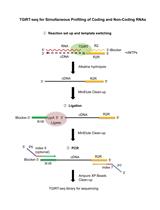- EN - English
- CN - 中文
Analyzing (Re)Capping of mRNA Using Transcript Specific 5' End Sequencing
使用转录本特异性5'端测序分析mRNA的(重新)帽化
发布: 2020年10月20日第10卷第20期 DOI: 10.21769/BioProtoc.3791 浏览次数: 3871
评审: Imre GáspárIndranil MalikRakesh Chatrikhi

相关实验方案

用于全面分析细胞、细胞外囊泡和血浆 RNA 中编码和非编码 RNA 生物型的 TGIRT-seq 方法
Hengyi Xu [...] Alan M. Lambowitz
2021年12月05日 6548 阅读
Abstract
The 5′ cap is a ubiquitous feature of eukaryotic mRNAs. It is added in the nucleus onto newly synthesized pre-mRNA, and in the cytoplasm onto mRNAs after decapping or endonuclease cleavage. Cytoplasmic recapping can occur after loss of the cap at the native 5′ end, or downstream within the body of the mRNA. The identification and location of recapping events is key to understanding the functional consequences of this process. Here we present an approach that addresses this problem, using the Lexogen TeloPrime® cDNA synthesis kit to tag recapped 5′ ends. TeloPrime uses a proprietary DNA ligase to add a double stranded DNA oligonucleotide onto the 3′ end of cDNA while it is base paired with mRNA. Specificity for capped ends is obtained by the oligonucleotide having an unpaired C residue that base pairs weakly with m7G on the mRNA 5′ end. This is followed by PCR amplification of double-stranded cDNA using primers to the appended oligonucleotide and the mRNA of interest. The resulting products are gel purified and sequenced directly (if a single band) or cloned and sequenced. The sequence at the junction between the ligated oligonucleotide and the target mRNA provides the location of the cap on the corresponding transcript. This assay is applicable to all capped transcripts. It can be used with Sanger sequencing for small numbers of transcripts or adapted for use with Illumina library sequencing.
Keywords: 5′ Cap (5'帽子)Background
The N7-methylguanosine cap is a distinguishing feature of all eukaryotic mRNAs. Proteins binding to the cap function all stages of the mRNA lifecycle, including nuclear processing, export, translation and mRNA decay. The 5′ cap is added co-transcriptionally to all mRNAs, and a number of genome wide techniques (e.g., Capped Analysis of Gene Expression, or CAGE) (Morioka et al., 2020) have been developed that use the identification of capped ends as a way to mark transcription initiation sites. In addition to marking transcription start sites approximately 25% of CAGE tags map downstream within spliced introns (Djebali et al., 2012). Evidence of the biochemical basis for this came from our lab’s identification in 2009 of a cytoplasmic complex capable of restoring the N7-methylguanosine cap onto transcripts with a 5′-monophosphate end, but not onto transcripts with a 5′-hydroxyl end (Otsuka et al., 2009). Cytoplasmic capping is catalyzed by a complex of enzymes including capping enzyme (RNGTT), cap methyltransferase (RNMT) and its activating subunit (RAM), and a kinase that converts the 5′-monophosphate ends of decapped transcripts to a 5′-diphosphate substrate for GMP addition (Trotman and Schoenberg, 2019). Our early work was based on use of a dominant negative form of capping enzyme that blocks cytoplasmic capping at the GMP addition step. Expression of this protein resulted in the appearance of a number of uncapped transcripts whose ends were mapped using 5’-RACE to the vicinity of downstream CAGE tags (Kiss et al., 2015; Berger et al., 2019). While encouraging, this approach has three major drawbacks; a) it requires separation of capped and uncapped RNAs, b) it assumes uncapped transcripts remain sufficiently stable to be detected, and c) it assumes uncapped ends detected in this manner have undergone limited additional exonucleolytic trimming.
These issues were resolved by the development of a new approach to inhibiting cytoplasmic capping that instead targets cap methylation (Del Valle Morales et al., 2020). Inhibition of cytoplasmic cap methylation results in the creation of recapped mRNAs with unmethylated G caps which are degraded by cap surveillance enzymes (Grudzien-Nogalska and Kiledjian, 2017). This makes it possible to identify cytoplasmic capping targets by quantitative changes in RNA-Seq data, thus eliminating assumptions about the stability and detectability of uncapped RNAs, the need to separate uncapped from capped RNAs, and concerns for exonucleolytic trimming. By simplifying the process of identifying cytoplasmic capping targets this approach makes it possible to study this process in any cells or tissues expressing the cytoplasmic cap methylation inhibitor. Finally, because these transcripts retain their caps, we paired this approach with a facile method for identifying capped ends that can be scaled from a few mRNAs to larger sequencing libraries.
Materials and Reagents
- 0.2 ml PCR tubes (e.g., BioExpress, GeneMate, catalog number: T-3225-1 )
- 1.7 ml plastic, sterile, RNase-free microcentrifuge tubes (e.g., BioExpress, GeneMate, catalog number: C-3262-1 )
- 10 cm or 15 cm culture dishes (e.g., Alkali Scientific, catalog numbers: TD0100 , TD0150)
- Sterile nitrile gloves
- 18 G needle
- Cell lifters (e.g., BioExpress, GeneMate, catalog number: T-2443-4 )
- Sterile, RNase-free tips for P10, P20, P100, and P1000 pipets
- CleanCap® mCherry mRNA (Trilink, catalog number: L-7203 )
- mCherry forward primer: ATGGTGAGCAAGGGCGAGGAG
- mCherry reverse primer: GCCACCCTTGGTCACCTTCAGC
- Gene specific primer
- U2OS cells (ATCC, catalog number: HTB-96 ) or HEK293 cells (ATCC, catalog number: CRL-1573 )
- RNase-free water (e.g., from a Millipore Synergy water purification system, 18.2 MΩ cm)
- TeloPrime Full-Length cDNA Amplification Kit V2 (Lexogen, catalog number: 013.24)
- RNA buffer (part of TeloPrime kit)
- DNA buffer (part of TeloPrime kit)
- Reverse transcription mix (RT) (part of TeloPrime kit)
- Reverse transcription primer (RTP) (part of TeloPrime kit)
- Enzyme mix 1 (E1) (part of TeloPrime kit)
- Ligation mix (LM) (part of TeloPrime kit)
- Enzyme mix 2 (E2) (part of TeloPrime kit)
- Second strand synthesis mix (SS) (part of TeloPrime kit)
- Enzyme mix 3 (E3) (part of TeloPrime kit)
- PCR forward primer (FP) (part of TeloPrime kit, 5’-TGGATTGATATGTAATACGACTCACTATAG)
- PCR reverse primer (RP) (part of TeloPrime kit)
- TeloPrime PCR mix (Telo PCR) (part of TeloPrime kit)
- Column binding buffer 1 (CB1) (part of TeloPrime kit)
- Column binding buffer 2 (CB2) (part of TeloPrime kit)
- Column wash buffer (CW) (part of TeloPrime kit)
- Purifications columns (part of TeloPrime kit)
- Collection tubes (part of TeloPrime kit)
- SensiFASTTM SYBR® No-ROX (Bioline, catalog number: BIO-98050 )
- SYBR Gold Nucleic Acid Gel Stain (Thermo Fisher Scientific, InvitrogenTM, catalog number: S11494 )
- DNA size marker (e.g., Thermo Fisher Scientific, InvitrogenTM, catalog number: AM7778 )
- 2x DNA loading dye (e.g., Thermo Fisher Scientific, Thermo ScientificTM, catalog number: R0641 )
- 40 U/μl RNaseOUT Recombinant Ribonuclease Inhibitor (Thermo Fisher Scientific, InvitrogenTM, catalog number: 10777019 )
- RNA Clean and Concentrator-25 (Zymo Research, catalog number: R1017 )
- DNA Clean and Concentrator-5 (Zymo Research, catalog number: D4013 )
- pGEM®-T Easy Vector Systems (Promega, catalog number: A1360 )
- pGEM®-T Easy Vector (part of pGEM®-T Easy Vector Systems kit)
- T4 DNA Ligase (part of pGEM®-T Easy Vector Systems kit)
- 2X Rapid Ligation Buffer ( part of pGEM®-T Easy Vector Systems kit)
- StellarTM Competent Cells (Clontech, catalog number: 636766 )
- Bacterial culture tube (e.g., VWR, catalog number: 20170-579 )
- LB Agar Ampicillin-100 (Sigma-Aldrich, catalog number: L5667 )
- NucleoSpin® Plasmid DNA Purification Kit (Clontech, catalog number: 740588.50)
- McCoy’s 5A medium (for U2OS cells; Thermo Fisher Scientific, GibcoTM, catalog number: 16600082 )
- Dulbecco’s modified Eagle medium (DMEM; for HEK293 cells; Thermo Fisher Scientific, GibcoTM, catalog number: 21013024 )
- Fetal bovine serum (FBS; Atlanta Biologicals, catalog number: S10350 )
- Phosphate-buffered saline (PBS; e.g., Thermo Fisher Scientific, GibcoTM, catalog number: 10010049 )
- RNase-free 10x Tris/borate/EDTA (TBE) buffer (e.g., Thermo Fisher Scientific, InvitrogenTM, catalog number: 15581 )
- Ethanol
- Isopropanol
- Sodium chloride (NaCl; e.g., Fisher Scientific, catalog number: BP358 )
- 5 M NaCl (e.g., Thermo Fisher Scientific, catalog number: AM9759 )
- 3 M sodium acetate, pH 5.2 (e.g., Thermo Fisher Scientific, Thermo ScientificTM, catalog number: R1181 )
- Ammonium persulfate (e.g., Sigma-Aldrich, catalog number: A3678 )
- 1 M Tris-HCl, pH 7.5 (e.g., AMRESCO, catalog number: E691 )
- 1 M magnesium chloride (MgCl2, e.g., Thermo Fisher Scientific, InvitrogenTM, catalog number: AM9530G )
- 2 M potassium chloride (KCl; e.g., Alfa Aesar, catalog number: J75896 )
- 0.1 M DTT (Thermo Fisher Scientific, catalog number: 707265ML )
- MyTaqTM Mix (Bioline catalog number: BIO-25041 )
- Tetramethylethylenediamine (TEMED) (Thermo Fisher Scientific, catalog number: 17919 )
- 40% Acrylamide/Bis Solution (Bio-Rad, catalog number: 1610144 )
- GlycoBlueTM Coprecipitant (Thermo Fisher Scientific, catalog number: AM9515 )
- 1x TBE (running buffer for urea-PAGE) (see Recipes)
- 10% (w/v) ammonium persulfate (see Recipes)
- Cytoplasmic lysis buffer (see Recipes)
- 8% native PAGE gel (see Recipes)
Equipment
- Eye protection
- NanoDrop spectrophotometer (Thermo Fisher Scientific, model: NanoDropTM 1000 , catalog number: ND-1000 ) or other instrument suitable for quantifying nucleic acids
- P10, P20, P100, and P1000 pipets
- Thermal cycler (e.g., MJ Research, model: PTC-200 )
- Quantitative PCR instrument (e.g., Bio-Rad CFX Connect Real-Time System)
- Heating block (e.g., Bioer, model: MB 101 )
- -80 °C freezer
- Water-jacketed humidified incubator (e.g., Thermo Fisher Scientific, Thermo ScientificTM, model: Forma® Series II ) set to 37 °C with 5% CO2
- Refrigerated centrifuge (Eppendorf, model: 5415 R )
- Programmable rotator-mixer (Grant Instruments, model: PTR-30 ) at 4 °C and set to 10 rpm orbital rotation
- Electrophoresis system for PAGE (e.g., Bio-Rad Laboratories, catalog number: 1660828EDU )
- Azure Sapphire Biomolecular Imager (or similar imaging system)
- UV transilluminator (BT Lab Systems, model: BT503 )
Software
- Microsoft Excel software
- ImageJ software
- Bio-Rad CFX Maestro software
- Adobe Photoshop
- Azure Sapphire Capture Software
Procedure
文章信息
版权信息
© 2020 The Authors; exclusive licensee Bio-protocol LLC.
如何引用
del Valle Morales, D. and Schoenberg, D. R. (2020). Analyzing (Re)Capping of mRNA Using Transcript Specific 5' End Sequencing. Bio-protocol 10(20): e3791. DOI: 10.21769/BioProtoc.3791.
分类
分子生物学 > RNA > RNA 加帽
分子生物学 > RNA > 转录
您对这篇实验方法有问题吗?
在此处发布您的问题,我们将邀请本文作者来回答。同时,我们会将您的问题发布到Bio-protocol Exchange,以便寻求社区成员的帮助。
提问指南
+ 问题描述
写下详细的问题描述,包括所有有助于他人回答您问题的信息(例如实验过程、条件和相关图像等)。
Share
Bluesky
X
Copy link











